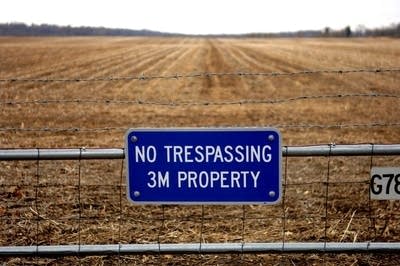State says PFC contamination is stabilized in east metro
Go Deeper.
Create an account or log in to save stories.
Like this?
Thanks for liking this story! We have added it to a list of your favorite stories.

The PFC contaminating the groundwater in parts of Oakdale, Lake Elmo, Woodbury, and Cottage Grove, comes from leaking landfills. 3M disposed of waste from its Scotchgard and fire retardant operations for many years in those three landfills.
But the good news seems to be that the pollution may have spread as far as it's going to go.
That's partly a natural process, according to Jim Kelly, a research scientist with the Minnesota Department of Health.
"We're talking a period of probably 30 to 40 years since the contamination got into the aquifer, it's had time to slow down, be diluted, disperse itself to its maximum potential, and we think that's what we're seeing now."
Turn Up Your Support
MPR News helps you turn down the noise and build shared understanding. Turn up your support for this public resource and keep trusted journalism accessible to all.
A network of containment wells at the landfills is also doing its work -- contaminated water is pumped out before it can enter the groundwater, Kelly says.
One of the strategies to clean up the landfills is to remove some if not all of the contaminated soil. It'll be trucked to a landfill in Rosemount.
Rep. Karla Bigham, DFL-Cottage Grove, represents the district. She questioned agency representatives closely about that plan.
"I want to make sure if in future times PFCs are deemed hazardous, which may happen, you don't know what the future holds, that where we are putting it is going to be acceptable for that purpose."
The Rosemount landfill is not certified to handle hazardous materials. But the MPCA says the three layers of liner that'll be used in the landfill will prevent future groundwater contamination. The older landfills that now hold the 3M waste don't have modern liners.
Jim Blackford has been following the clean-up plans closely. He lives near one of the landfills, and he's installed a filter for his drinking water. He urged legislators to find a permanent solution to the contamination, rather than just moving the polluted soil from one landfill to another.
"Because we're just shifting the cost to successive generations. I think it is morally reprehensible that our generation is not paying its own way with respect to pollution. If people want polluting products, they need to pay the full cost of the polluting products."
But most of the legislators seemed satisfied with the agency reports. Sen. Kathy Saltzman, DFL-Woodbury, represents 11 east metro communities.
"This all happened 19 months ago. And when you look at many of the things that have happened in the past 19 months in response to this, a lot has happened. So I think that reflects cities working together with the state and legislators to find solutions, and obviously I think it needs to be monitored as well."
Two perfluoronated chemicals, PFOA and PFOS, have been known to cause cancer in lab animals. A third perfluoronated chemical, PFBA, is not considered as potentially harmful, but less is known about it.
In the meantime, the MPCA has been moving farther a field to look for PFCs is area lakes and rivers. A year and a half ago, the agency found fish in Lake Calhoun were contaminated with PFCs, on the other side of the metro from the disposal sites and 3M's operations. The source of that contamination is still a mystery. But one possible source is firefighting foam, once made by 3M.
The MPCA is investigating whether fire departments around the state still have stockpiles that they're using for training.
Dear reader,
Political debates with family or friends can get heated. But what if there was a way to handle them better?
You can learn how to have civil political conversations with our new e-book!
Download our free e-book, Talking Sense: Have Hard Political Conversations, Better, and learn how to talk without the tension.




